ASUS' N82Jv: Jack-Of-All-Trades
by Jarred Walton on September 11, 2010 11:10 PM ESTASUS N82Jv-X2 High Quality
So just how far can we push the GT 335M before it hits the wall? Our Medium settings are a good blend of quality and performance, but move up to High settings and performance starts to plummet—especially if you want to run at higher resolutions. In that regard, the 768p LCDs that are everywhere these days are a benefit. Then again, you can always run a 900p or 1080p at a lower resolution if you need to, but you'll never get a 1080p desktop experience out of a 768p display. We've included results for the N82Jv at both native resolution and our standard 900p High setting using an external LCD. This time, it goes up against some far more capable mobile gaming systems, and we're not expecting much.
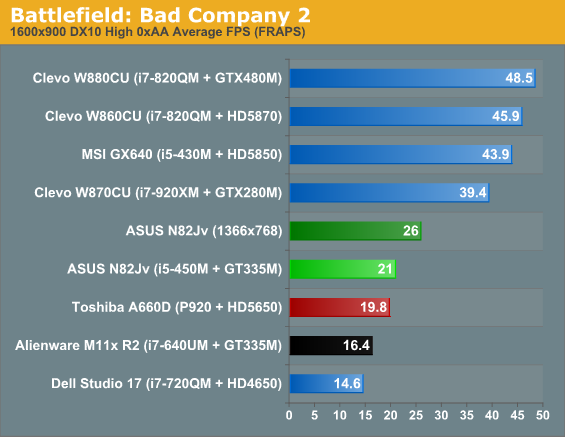
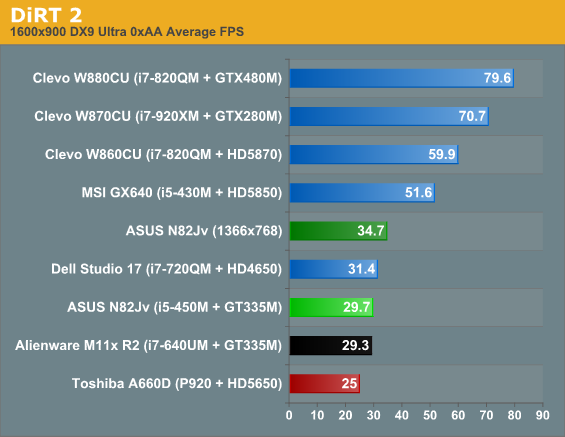


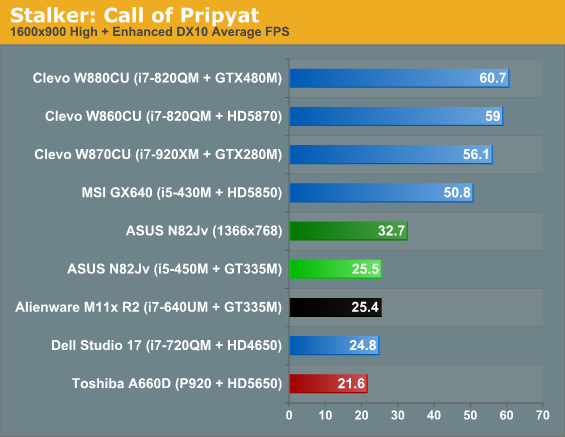
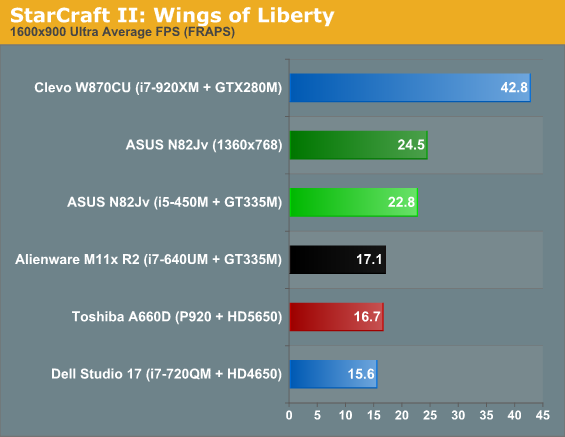
At our "High" settings and native 768p resolution, the N82Jv still manages to post nearly playable results in most of the games, with only BFBC2 and SC2 falling below the 30FPS threshold. However, there's a huge gap between the GT 335M and the high-end GPUs like the 280M, HD 5850/5870, and 480M. All of those turn in average frame rates that are more than twice as fast as the GT 335M at 900p. What we're really interested in seeing is where the new midrange 425M and 435M parts fall, particularly if they can hit the same price and power point as the 335M!
3DMark Performance
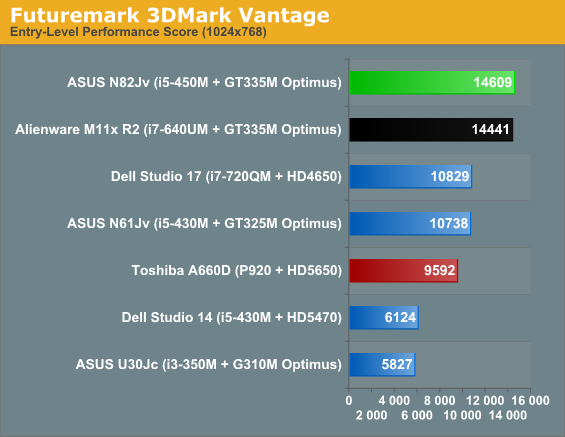
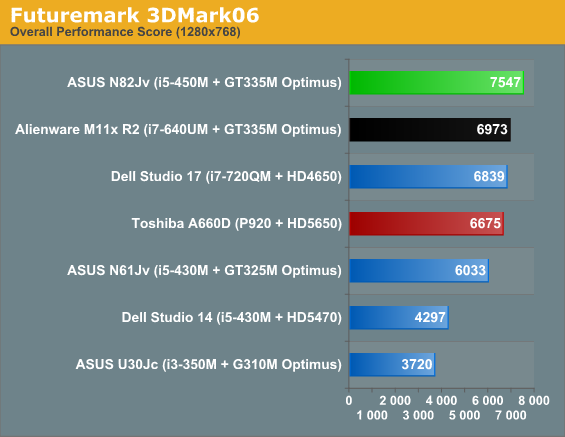
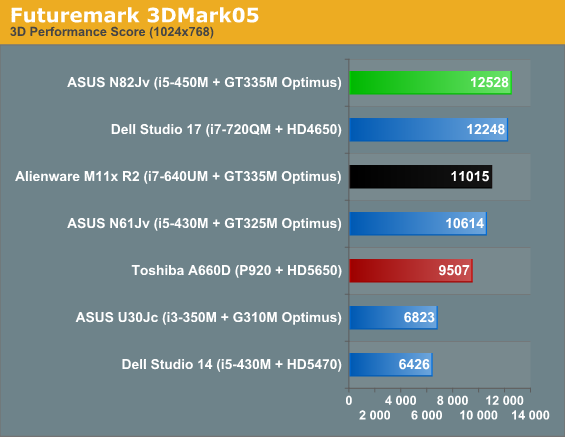
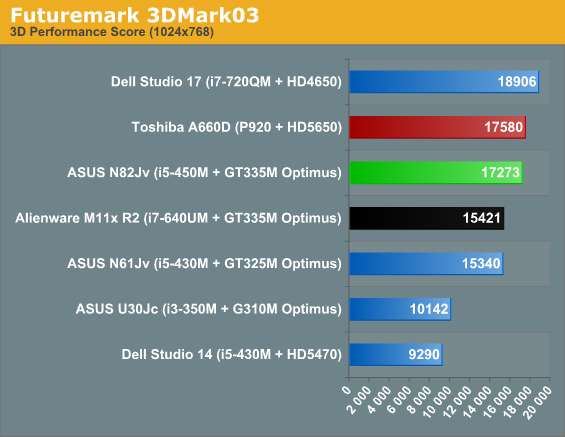
How about the ubiquitous 3DMark? We've saved this one for last, mostly because we don't consider it a replacement for gaming tests. The results are similar (in some cases) to our gaming tests, though margins are smaller relative to the M11x R2. 3DMark has always been more of a GPU rather than a CPU stress test, so seeing the two GT 335M systems score so similarly isn't a surprise. The gap between the N82Jv and the A660D on the other hand covers a wide range; it's a dead heat in 3DMark03, a 13% lead for the N82JV in 06, 32% in 05, and 52% in Vantage. Vantage does incorporate some CPU testing and PhysX into the mix, so that may explain the gap there, but obviously there's a lot going on that a single number doesn't properly disclose.










33 Comments
View All Comments
FH123 - Sunday, September 12, 2010 - link
Good grief, how do you come up with those numbers? Show some consideration for people with different (yes, probably worse) eyes than yours. My preference is for 1024x768 at 14". My gripe is that the choice has gone away. My next choice would be 1280x800. Even that wasn't available in the low-weight, premium machine I bought. My ultimate choice would be something close to (laser) printed quality, e.g. 300 dpi upwards, and all the scaling problems solved by the OS. In the meantime, while we're at the resolutions you mention, I inevitably end up using some form of anti-aliasing, e.g. ClearType. That doesn't exactly make things better at the sort of awkward neither here (traditional screen < 100) nor there (traditional printer > 300) DPI we have at the moment.seanleeforever - Monday, September 13, 2010 - link
as a owner of both the BEST notebook screen in business, i think i know what i am talking about:screen resolution has absolutely NOTHING to do with screen quality, period. you guys are simply drinking Kool-Aid that notebook company tend to sell you. a higher resolution screen doesn't make it better than lower resolution screen, just as a 17 inch notebook is not better than 12 inch notebook (except it is larger).
the technology used in the panel is what decides screen quality. i have HP dream color 2 on my elitebook and outdoor screen on my x201 tablet. both uses 10 bit IPS screen that delivers superb image with NO color distortion at any angel, both are 300~400 dollar option on the top of the SAME RESOLUTION screen.
a good screen cost A lot of money, much higher than simply put more pixel on the screen. that's why notebook manufacturers try to fool you.
simply put, i will love to a 1200*800 ips than blue LED TN screen of any resolution.
Roland00 - Sunday, September 12, 2010 - link
You don't need direct x 11 with a laptop. Any game that you would want direct x 11 you would want a card that is faster than a 9800gt (aka 5750 or GTS 450 desktop parts) or else the card would be too slow to perform an acceptable frame rate with direct x 11 effects added on. Now in theory a game could be "completely" direct x 11 where you wouldn't have a direct x 9 or direct x 10 mode but this won't happen for games are developed for consoles and are developed for pc marketshare and too few people have direct x 11 cards thus their will be a direct x 9 and/or direct x 10 code path.That said the upcoming 400 series nvidia cards are looking to be faster than this card for they have a higher amount of shaders (the 420m, 430m, and 435m will all have 96 shaders, the difference between each model is the core clock and the shader clock, they have identical memory bandwidth). Whether this will provide an insignificant boost slightly different architecture, and/or memory bandwidth is anybody guess but I wouldn't be surprised to see at least a 20% performance boost for they have 25% more shader hardware, and all even the 420m has higher clocks than the 335m. (and the 435m is 30% faster on the core and shader clock compared to the 420m).
Get the 400 series not because of direct x11 but because it will be a faster card, and battery life isn't a big deal due to optimus.
Voldenuit - Sunday, September 12, 2010 - link
What use is a low-end DX11 GPU? Even midrange desktop DX11 GPUs struggle with DX11 games, so they are doubly useless on a laptop.A DX10 GPU can do most anything a DX11 one can.
DirectCompute? Check.
CUDA? Check.
OpenCL? Check.
PhysX? Check (not that you'd want to turn on Physx on a laptop, unless you were a masochist).
If you're building a high end (or even midrange) desktop, DX11 is the clear choice, but on the mobile front, it's hardly essential.
I do agree that with the shoddy battery, lousy screen and mediocre keyboard, there isn't much to entice me with the ASUS in any case.
Aaluran - Sunday, September 12, 2010 - link
I couldn't possibly agree more with this article. The LCD is an annoyance, but one I can live with, but that battery is laughable compared to the 84Wh one. This laptop is perfect as a second computer, but 47Wh is simply unaccpetable.strikeback03 - Monday, September 13, 2010 - link
That is one point I disagree on, IMO 3-4 hrs is good enough for a lot of mainstream users. Make a larger one available (as part of the purchase) for those who want it, but I find the LCD far more a problem than the battery.blackrook - Sunday, September 12, 2010 - link
The last two pages of this article just scream "HP Envy 14 with radiance screen!" to me. It's a huge shame Anandtech doesn't appear to have one on hand. I was surprised it was never mentioned. This is a laptop with:-magnesium/aluminum chassis
-switchable 5650 graphics (albeit underclocked and not Optimus)
-sensational screen
-acceptable battery capacity (59Wh?)
And it seems to be making waves. The Envy 14 upon initial release originally came standard with the radiance screen at $1099, until demand seemed to outpace supply. It became $999 with a standard brightview screen, radiance being as a $200 option. Since then the radiance screen has ballooned to a $300 premium. That's how much perceived value a quality screen is worth to consumers, and it stuns me why more manufacturers haven't tried to go the same route HP has with the Envy 14.
Just some food for thought.
The Crying Man - Sunday, September 12, 2010 - link
Jarred mentioned that an Envy 14 was on it's way some weeks ago. Hopefully it's in the process of being reviewed now.JarredWalton - Sunday, September 12, 2010 - link
It still hasn't arrived... it seems HP can be like that. Plus, the current Envy 14 is now what, 6 months old? It's about due for an update.blackrook - Sunday, September 12, 2010 - link
It released in late June, and first day buyers started receiving them early July. So that'd make it around two and a half months old.So HP was supposed to send over a review unit and it never arrived? :S
*shakes head*